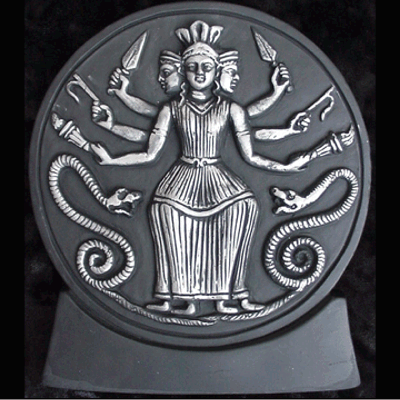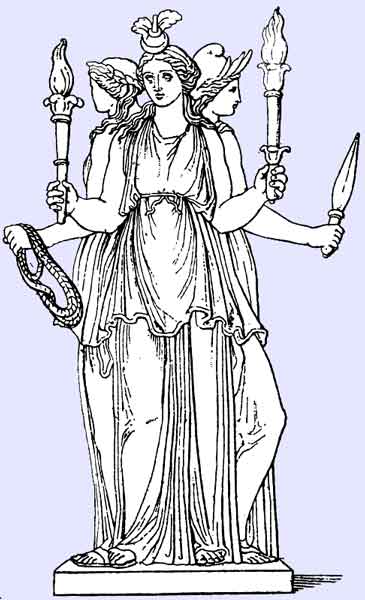You are currently browsing the tag archive for the ‘Night’ tag.
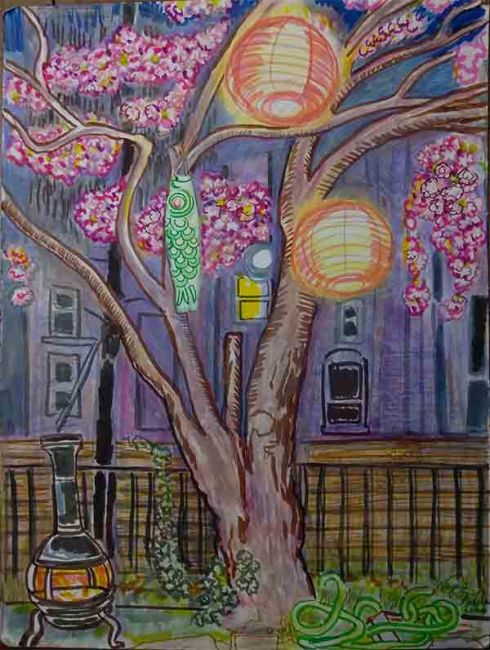
Cherry Tree at Dusk (Wayne Ferrebee, 2020), watercolor and colored pencil on paper
There is a large & venerable Kwanzan Cherry Tree in my backyard in Brooklyn. Each year it blooms for a week (or less) and during that time the garden becomes transcendent in its sublime pink beauty. Nothing symbolizes the sacred renewal of spring more than the cherry blossoms (which I have blogged about often in the past).
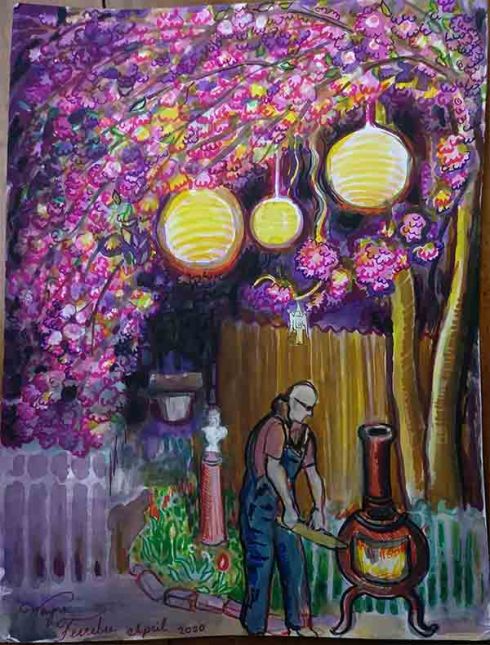
Rennie Burning the Broken Fence (Wayne Ferrebee, 2020) Watercolor on paper
Year after year the blossoms come and go so quickly, and, stumbling along behind, I try to capture their evanescent glory with my art. Yet I am never satisfied. This strange pandemic year, I had a bit more time in the garden to draw (after all there were no blossom parties to prepare for) and…for a moment I thought that perhaps I got a bit closer to capturing a smidgen of the tree’s beauty. Yet, now that I have photographed the drawings and watercolor paintings, suddenly they seem alien from the tree’s living glory.

Cherry Blossoms and Holly at Night (Wayne Ferrebee, 2020) Watercolor
So it goes with human endeavor, I suppose. At any rate, here are the drawings. There is a fierce wind howling outside right now (and near freezing temps) so I have a feeling that this is the blossom art portfolio for this year (although maybe I will try some more tulip paintings before those go too). It all goes so fast. it is all so beautiful.

Cherry Blossoms and Tulips (Wayne Ferrebee, 2020) Watercolor on paper
Anyway, here are my cherry blossom paintings this year. Take care of yourself and be safe. There will be another spring next year when we can have the full party with all of the trappings!
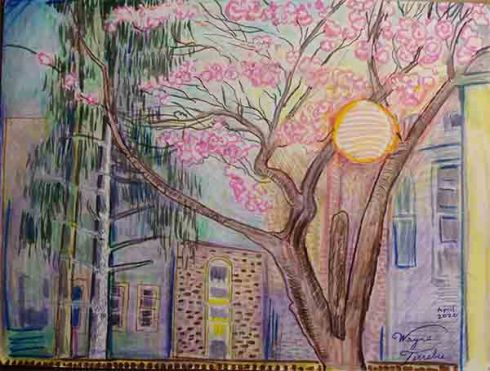
Cherry Blossoms on Easter (Wayne Ferrebee, 2020) Watercolor and Colored Pencil on Paper
When I was young I received a copy of D’Aulaires’ Book of Greek Myths, which I loved. I memorized the characters and stories from the book and suddenly the world of art and poetry opened up to me. The book remains a delightful mythology primer for any child. However, later when I read actual Greco-Roman literature, I realized that D’Aulaire’s had left out a goddess of great importance to the Greco-Roman world (among other things…). The omission seems fitting however, for the missing goddess was Hecate, the goddess of magic, poison, night, thresholds, boundaries, and crossroads. The Oxford Classic Dictionary asserts that Hecate “is more at home on the fringes than in the center of Greek polytheism. Intrinsically ambivalent and polymorphous, she straddles conventional boundaries and eludes definition.” This seems correct. Even in classical passages which hold her in high esteem, Hecate seems to be an outsider among the gods. Her very name means “the distant one”.

Hekate, dressed as a huntress, wielding a pair of Eleusinian torches at Heracles and Cerberus (Attic vase, ca. 310 BC)
Hecate may seem like a strange outsider in the Greek pantheon because she was an outsider in the Greek pantheon. Some scholars believe she was originally a Thracian moon goddess based, in turn, on an ancient and powerful Anatolian goddess. Unlike other outsider gods, who frequently worked their way into the Greek canon as animal demons, Hecate struck a chord with the Greeks and became a focus of their mystery cults. Additionally she had an influential worshipper early on in Greek culture: there are few if any references to Hecate before she appears in the works of Hesiod (a major source of Ionic thought who was active sometime between 750 and 650 BC). Yet in Hesiod’s Theogeny she is a major force of the universe. Perhaps this is because Hesiod’s father was reputedly from Aeolis (a region of Anatolia). It could be that Hesiod was honoring a local goddess, and his writings became instrumental to securing her place in the Greek canon (where she nonetheless remains an alien).
Hesiod wrote that Hecate was the only child of two Titans, Asteria (goddess of the stars) and Peres (god of might). Hesiod seems to have regarded her as beautiful and powerful. In Theogeny, he wrote,
For to this day, whenever any one of men on earth offers rich
sacrifices and prays for favour according to custom, he calls
upon Hecate. Great honour comes full easily to him whose prayers
the goddess receives favourably, and she bestows wealth upon him;
for the power surely is with her….
The son of Cronus did her no wrong nor took anything away of all that
was her portion among the former Titan gods: but she holds, as
the division was at the first from the beginning, privilege both
in earth, and in heaven, and in sea. Also, because she is an
only child, the goddess receives not less honour, but much more
still, for Zeus honours her.
Greek writers of the 5th century, maintained Hesiod’s respect for Hecate but they saw her in a darker light. Euripides writes about her as the patron deity of the sorceress Medea and quite a few of that baleful witch’s invocations are directly to Hecate.
Whatever Hecate’s origins in the near east and ancient Greece, Hecate had morphed from a moon goddess and protector of the young into underworld queen by the era of Alexander, and that is how she was subsequently worshipped by the Romans (who held her very dear). In Hellenic times and afterwards, Hecate is pictured as a triple goddess. Sometimes she has been portrayed with three young beautiful faces, but other times she is depicted as simultaneously being a maiden, a mother, and a crone (which seems to be how her contemporary worshippers see her). Likewise, in one or more of her six arms she always holds a torch. The other items vary between serpents, keys, daggers, ropes, herbs, and mystery charms. Speaking of serpents, she was occasionally portrayed with serpent legs or serpent limbs.
The snake was by no means the only creature affiliated with Hecate. Like many chthonic deities of the Mediterranean, she was associated with dogs (particularly black female dogs). She is said to have had two demon hounds which did her bidding (although it hardly seems important since she was a sorceress of matchless puissance). Additonally, dogs were sacrificed to her and eaten in her honor. Snakes, owls and other nocturnal creatures were variously seen as sacred to the goddess as was the red mullet, a blood-colored goatfish (which wealthy Romans kept in salt water pens to pamper and train as pets). In terms of botanical symbolism, all manner of poisons were her bailiwick and she was invoked by poisoner and victim alike. The yew, with its dark symbolism, was particularly sacred to Hecate, and her worshippers planted them around her temples and mystery cult sites.
As goddess of thresholds she was called on to help people through the two greatest thresholds. She was worshiped both as a midwife (some say the knife and rope in her hands were for tying umbilical cords) and as a sort of supernatural hospice nurse (some assert that her knife, rope, and herbs could be used to slip into the next realm). Like Athena and Diana, Hecate was a virgin goddess.
I mentioned Hecate’s contemporary worshipers earlier. Unlike the other Greek gods, who may still inspire artists, poets, and antiquarians but rarely elicit prayers, Hecate continues to have a worldwide following. Neopaganism has suited her admirably and she has even appeared in a number of hit TV shows. Her mysterious protean nature seems to appeal to the diffuse and highly-individualized practitioners of Wicca. One can only imagine how the surly and chauvinistic Hesiod would feel if told that his beloved Hecate had outlived his beloved Olympian Gods to be worshiped and called on as a feminist icon!
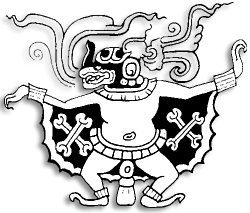 One of the most horrible deities of the underworld comes from the violent and frightening cosmology of the Maya civilization of Central America. The Mayan god of darkness, violence and sacrifice was Camazotz a flying bat god who inhabited Xibalba, the Mayan hell. Originally an anthropomorphic bat monster worshipped by the Zapotec Indians of Oaxaca, Camazotz was adopted into the Mayan pantheon as a vampire killer who reveled in slaughter. The deity appears throughout classical Mayan art and sculpture. Camazotz also features in the post-classical compendium of Mayan myths, the Popul Vuh, where he is master of a house of were-bats like himself. There he (or one of his minions) claws off the heads of one of the story’s twin heroes during their attempt to defeat the lords of Xibalba in a marathon ball tournament.
One of the most horrible deities of the underworld comes from the violent and frightening cosmology of the Maya civilization of Central America. The Mayan god of darkness, violence and sacrifice was Camazotz a flying bat god who inhabited Xibalba, the Mayan hell. Originally an anthropomorphic bat monster worshipped by the Zapotec Indians of Oaxaca, Camazotz was adopted into the Mayan pantheon as a vampire killer who reveled in slaughter. The deity appears throughout classical Mayan art and sculpture. Camazotz also features in the post-classical compendium of Mayan myths, the Popul Vuh, where he is master of a house of were-bats like himself. There he (or one of his minions) claws off the heads of one of the story’s twin heroes during their attempt to defeat the lords of Xibalba in a marathon ball tournament.
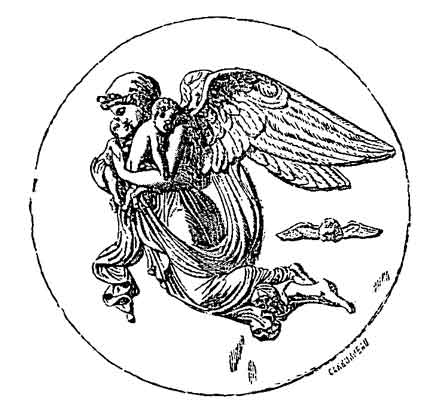 One of the most enigmatic Greek divinities is Nyx, the primordial goddess of the Night. In Hesiod’s Theogeny she was a child of Chaos, but, in other texts, Nyx was present at (or before) creation and had no parents. She is rarely mentioned in classical texts, but the few times she does appear are noteworthy. Some of her children include Death (Thanatos), Sleep (Hypnos), Mockery (Momus), Dreams (Morpheus), and the Fates (Moirae)–they represent various slantwise forces which even the Olympian gods are subject to.
One of the most enigmatic Greek divinities is Nyx, the primordial goddess of the Night. In Hesiod’s Theogeny she was a child of Chaos, but, in other texts, Nyx was present at (or before) creation and had no parents. She is rarely mentioned in classical texts, but the few times she does appear are noteworthy. Some of her children include Death (Thanatos), Sleep (Hypnos), Mockery (Momus), Dreams (Morpheus), and the Fates (Moirae)–they represent various slantwise forces which even the Olympian gods are subject to.
Nyx is mentioned in Chapter XIV of Homer’s Illiad, when the sleep god Hypnos refuses to carry out Hera’s bidding. Hypnos describes the past results of putting Zeus to sleep (against Zeus’ will) and relates how his mother saved him:
“Jove was furious when he awoke, and began hurling the gods about all over the house; he was looking more particularly for myself, and would have flung me down through space into the sea where I should never have been heard of any more, had not Night who cows both men and gods protected me. I fled to her and Jove left off looking for me in spite of his being so angry, for he did not dare do anything to displease Night. And now you are again asking me to do something on which I cannot venture.” [Forgive the Roman names—I used the Johnson translation for ease of citation and copying. Also, obviously, Nyx is called “Night” as she is in the rough Aristophanes quote below. I’ll try to find some prettier translations later.]
Nyx is also mentioned in Orphic cult poetry (certain mystery cult poems were attributed to the demigod Orpheus) where she is portrayed as a bird/woman with black wings who first created the universe. She dwells in a cave at the edge of the Cosmos. With her in the eternal darkness is Kronos, Zeus’ father, who was savagely mutilated by his son. Kronos is unconscious, drunk on magical honey, and he mutters prophecies which Nix then chants. Outside the cave is Zeus’ nursemaid, Adrasteia, who acted as mother for the king of the gods during his boyhood. Adrasteia keens and beats a cymbal to Nyx’s chanting and the entire universe subtly moves to the rhythm of her cymbal.
Aristophanes alludes to the Orphic mystery poetry in a chorus from his play “The Birds”. The chorus is sung by birds who have a different take on creation. In their interpretation, night is a bird and they are descended from her via love and chaos. Here is the relevant portion of their song:
…At the start,
was Chaos, and Night, and pitch-black Erebus,
and spacious Tartarus. There was no earth, no heaven,
no atmosphere. Then in the wide womb of Erebus,
that boundless space, black-winged Night, first creature born,
made pregnant by the wind, once laid an egg. It hatched,
when seasons came around, and out of it sprang Love—
the source of all desire, on his back the glitter
of his golden wings, just like the swirling whirlwind.
In broad Tartarus, Love had sex with murky Chaos.
From them our race was born—our first glimpse of the light
not before Love mixed all things up. But once they’d bred
and blended in with one another, Heaven was born,
Ocean and Earth—and all that clan of deathless gods.
Thus, we’re by far the oldest of all blessed ones,
for we are born from Love. There’s lots of proof for this.
We fly around the place, assisting those in love—
[Translation by Ian Johnston]
Although a few small temples and cults to Nyx existed, she was not often worshiped openly in Greece (nor, for that matter, were her children). However Nyx was in the background of many other god’s temples and ceremonies as a statue or a sacred phrase. Around her name and mythos was an impalpable shroud of ambiguity. To the Greeks, Nyx was older and stranger than the gods they cared about and worshiped–she was the first and original outsider.





